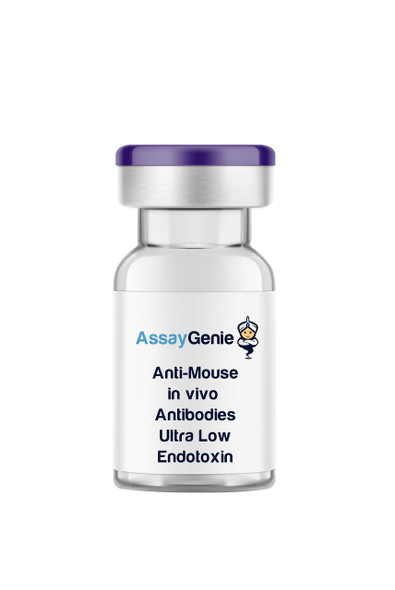Anti-Mouse CD209b In Vivo Antibody - Ultra Low Endotoxin
- SKU:
- IVMB0054
- Product Type:
- In Vivo Monoclonal Antibody
- Clone:
- 22D1
- Protein:
- CD209b
- Isotype:
- Armenian Hamster IgG1 kappa
- Reactivity:
- Mouse
- Synonyms:
- DC-SIGNR1
- Research Area:
- Immune Checkpoint & Cancer Biology
- Macrophage Cell Depletion
- Endotoxin Level:
- Ultra Low Endotoxin
- Host Species:
- Armenian Hamster
- Applications:
- Blocking
- FC
- IHC FF
- WB
Description
| Product Name: | Anti-Mouse CD209b In Vivo Antibody - Ultra Low Endotoxin |
| Product Code: | IVMB0054 |
| Size: | 1mg, 5mg, 25mg, 50mg, 100mg |
| Clone: | 22D1 |
| Protein: | CD209b |
| Product Type: | Monoclonal Antibody |
| Synonyms: | DC-SIGNR1 |
| Isotype: | Armenian Hamster IgG1 κ |
| Reactivity: | Mouse |
| Immunogen: | Purified Recombinant Mouse CD209b (C-terminal peptide) |
| Applications: | B, FC, IHC FF, WB |
| Formulation: | This monoclonal antibody is aseptically packaged and formulated in 0.01 M phosphate buffered saline (150 mM NaCl) PBS pH 7.2 - 7.4 with no carrier protein, potassium, calcium or preservatives added. |
| Endotoxin Level: | <0.5 EU/mg as determined by the LAL method |
| Purity: | ≥98% monomer by analytical SEC >95% by SDS Page |
| Preparation: | Functional grade preclinical antibodies are manufactured in an animal free facility using only In vitro protein free cell culture techniques and are purified by a multi-step process including the use of protein A or G to assure extremely low levels of endotoxins, leachable protein A or aggregates. |
| Storage and Handling: | Functional grade preclinical antibodies may be stored sterile as received at 2-8°C for up to one month. For longer term storage, aseptically aliquot in working volumes without diluting and store at -80°C. Avoid Repeated Freeze Thaw Cycles. |
| Applications: | B, FC, IHC FF, WB |
| Reactivity: | Mouse |
| Host Species: | Armenian Hamster |
| Specificity: | Clone 22D1 recognizes an epitope on mouse CD209b. |
| Antigen Distribution: | CD209b is predominantly expressed on macrophages in the spleen marginal zone and lymph nodes medulla. |
| Immunogen: | Purified Recombinant Mouse CD209b (C-terminal peptide) |
| Concentration: | ≥ 5.0 mg/ml |
| Endotoxin Level: | <0.5 EU/mg as determined by the LAL method |
| Purity: | ≥98% monomer by analytical SEC >95% by SDS Page |
| Formulation: | This monoclonal antibody is aseptically packaged and formulated in 0.01 M phosphate buffered saline (150 mM NaCl) PBS pH 7.2 - 7.4 with no carrier protein, potassium, calcium or preservatives added. |
| Preparation: | Functional grade preclinical antibodies are manufactured in an animal free facility using only In vitro protein free cell culture techniques and are purified by a multi-step process including the use of protein A or G to assure extremely low levels of endotoxins, leachable protein A or aggregates. |
| Storage and Handling: | Functional grade preclinical antibodies may be stored sterile as received at 2-8°C for up to one month. For longer term storage, aseptically aliquot in working volumes without diluting and store at -80°C. Avoid Repeated Freeze Thaw Cycles. |
CD209b has a molecular weight of 37 kD and is a single-pass type II membrane protein containing a C-type lectin domain. CD209b plays a role in innate immune response, mediating the recognition and uptake of pathogen products such as lipopolysaccharides, pneumococcal polysaccharides, and dextrans. CD209b is a mouse homolog of human CD209, also known as DC-SIGN. Both primates and mice have several paralogs of CD209 that, within the species, are more comparable to each other than to orthologs of other species. Although DC-SIGN expression is similar in function and dendritic expression in both mice and humans, they are not unique orthologs. Higher primates have at least three DC-SIGN genes (DC-SIGN, DC-SIGNL1 and DC-SIGNL2); although DC-SIGNL2 has not been detected in humans. Up to eight paralogs of DC-SIGN have been reported in some laboratory mouse strains, some of which are differentially expressed on different cell types. On macrophages, DC-SIGN activates phagocytosis via the recognition and binding of mannose type carbohydrates, a class of pathogen associated molecular patterns (PAMPs) frequently found on viruses, bacteria and fungi. On myeloid and pre-plasmacytoid dendritic cells, DC-SIGN initiates immune response via the recognition of pathogen haptens (which elicits the production of antibodies), in addition to the mediation of dendritic cell rolling interactions with blood endothelium and activation of CD4+ T cells. Furthermore, DC-SIGN functions as receptor for viruses such as HIV and Hepatitis C. DC-SIGN, in conjunction with other C-type lectins, also plays a role in the recognition of tumors via dendritic cells. Hence, the therapeutic potential for DC-SIGN as a target for dendritic cell based cancer vaccine.
| Technical Datasheet: | View |
| Protein: | CD209b |
| Function: | CD209B is a C-type lectin receptor, mediating the recognition of various bacteria and viruses during innate immue response. |
| Ligand/Receptor: | CD209B binds to microbial polysaccharides and is a receptor for ICAM-3. |










